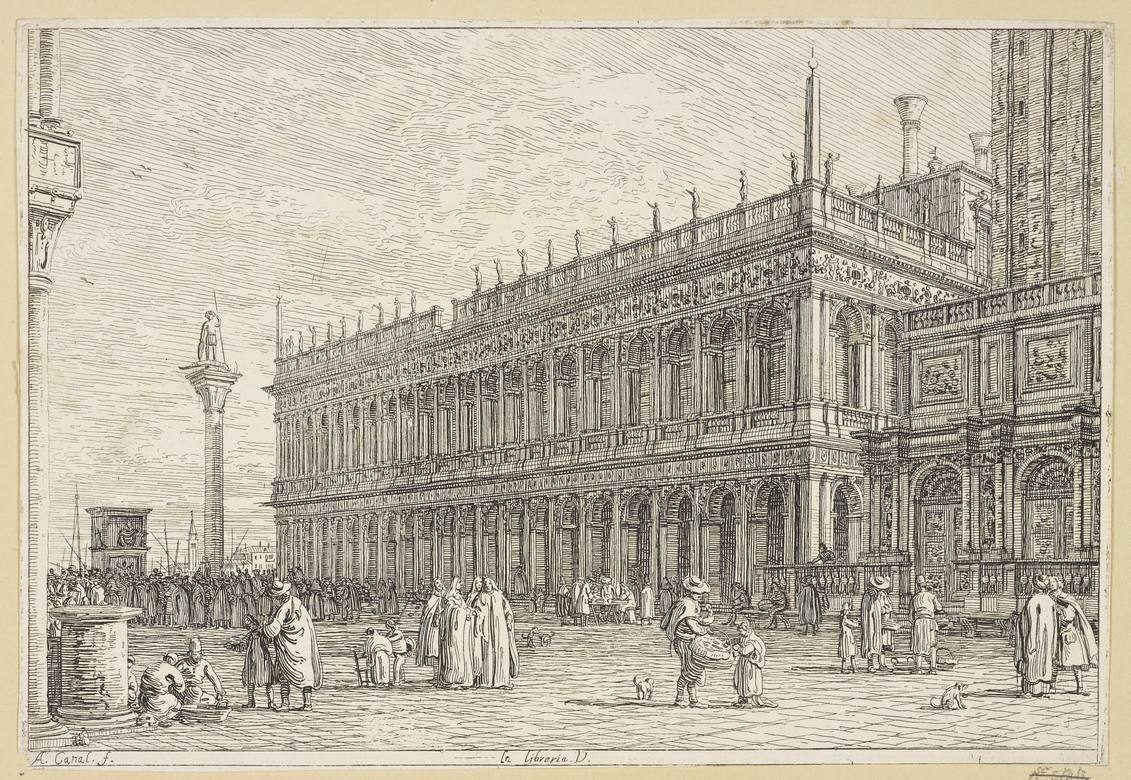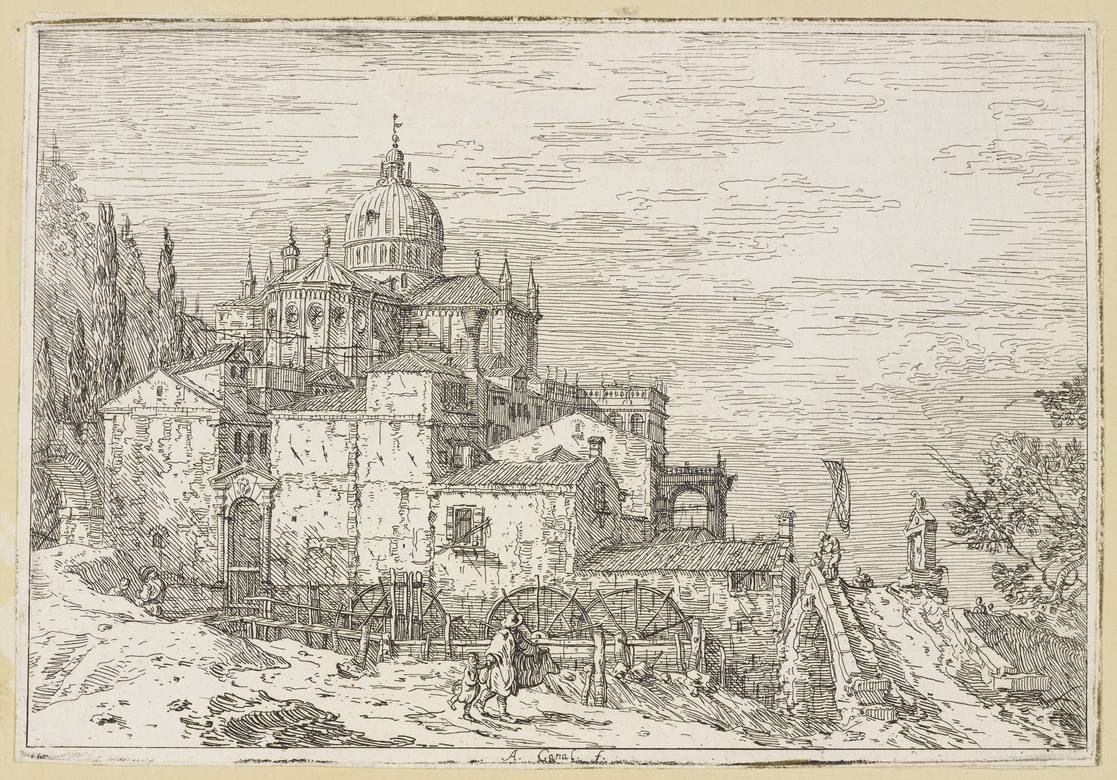
Etchings
Cheap paintings or a creative choice?
It is not really clear why Canaletto, in a period when the demand for his paintings was dropping because of the War of the Austrian Succession (1740-48), and the big drop in tourists number doing the Grand Tour in Italy, and Venice being an important spot, started doing the etchings.
Very unlikely it must have been for financiary reasons, but there is a great possibility that his patron Giuseppe Smith, pushed him in a new direction, because he had a great interest in printmaking.
Smith may have taken the occasion - in seeing Canaletto with extra time in his hands - to push him in this new artistic adventure.
Canaletto took the possibility to put on paper some Capricci he had in his head, and never had time (or request!) to create on canvas.
On the other hand a very acclaimed etcher which was gaining his space in the Art World like Antonio Visentini (1688-1782), went straight to use some of Canaletto's more acclaimed paintings to print on paper.
Some samples here:
Etchings were more affordable (a certain number was printed) and sometimes they could come in a book, with a good quantity of images, that made the book precious as a souvenir and as an Art piece.
Etchings were made in small sizes or quite big ones, going from 14x21 cm (half of an A4 regular printer paper sheet), to quite considerable sizes - like 35x50 cm - already a good image to be quite appreciated when framed and hung on a wall, without colors, though.
![Canaletto: [ca. 1735-46] - La torre di Malghera - Etching - National Gallery of Art, Washington, DC](../images_db/Canaletto_1735-46ca__e138__p282_La_torre_di_Malghera__NGA_1985.64.139.jpg)

![Canaletto: [ca. 1740s] - Torre di Malghera (The Tower of Malghera) - Oil on canvas - Private Collection](../images_db/Canaletto_1740s_ca__p282_Torre-di-Malghera-gp.jpg)
![Canaletto: [ca. 1735-46] - S. Giustina in Pra' della vale - Etching - National Gallery of Art, Washington, DC](../images_db/Canaletto_1735-46ca__e143__d149_S._Giustina_in_Pra_della_vale__NGA_1985.64.145.jpg)
![Canaletto: [ca. 1742] - Padua - The Prato della Valle with Santa Giustina - Drawing - Pen and ink, with grey wash, and a red chalk horizon line, over pencil and pinpointing - Royal Collection Trust, RCIN 907509](../images_db/Canaletto_1742ca__d149_Padua--The-Prato-della-Valle-with-Santa-Giustina--RCIN-907509.jpg)
![Canaletto: [ca. 1740] - Mestre - Etching - Royal Collection Trust, RCIN 807844](../images_db/Canaletto_1740ca__e032a_Mestre--RCIN-807844.jpg)
![Canaletto: [ca. 1740] - Veduta di Mestre, Le Riva delle Barche e l'Antica Posta (View of Mestre, alle Barche) - Oil on canvas - Fondation Bemberg, Toulouse](../images_db/Canaletto_1740ca__p082_Vue_de_Mestre_Canaletto_Bemberg_Fondation_Toulouse-Inv_1010.jpg)
![Antonio Visentini: [1742] - The Bacino di S Marco on Ascension Day - Etching - Royal-Collection-Trust, London](../images_db/Antonio-Visentini-1735-46--e091--p067_The-Bacino-di-S-Marco-on-Ascension-Day--RCT-UK--706815-1503658938-gp.jpg)
![Canaletto: [1733-34] - The Bacino di S Marco on Ascension Day - Oil on canvas - Royal Collection Trust](../images_db/Canaletto_1733-34ca__p067_The-Bacino-di-S-Marco-on-Ascension-Day--Royal-Collection-Trust-120085447_o-gp.jpg)
![Antonio Visentini: [1735] - Platea S.Maria de Iubanico vulgo Zobenigo - VI (Campo Santa Maria Zobenigo ) - Etching](../images_db/Antonio-Visentini-1735-46--e070--p097--Campo-Santa-Maria-Zobenigo--m010246_1.jpg)
![Canaletto: [1730s] - Campo Santa Maria Zobenigo - Oil on canvas - Metropolitan Museum of Art, New York](../images_db/Canaletto_1730s__p097_Campo_Santa_Maria_Zobenigo_500289ld.jpg)
![Antonio Visentini: [1735] - Nauticum Certamen cum Prospectus ab Aedibus Balborum, ad Pontem Rivoalti - XIII (A Regatta on the Grand Canal ) - Etching](../images_db/Antonio-Visentini-1735-46--e064--p105--A-Regatta-on-the-Grand-Canal--m010105_1.jpg)
![Canaletto: [1733-34] - A Regatta on the Grand Canal - Oil on canvas - Royal Collection Trust](../images_db/Canaletto_1733-34ca__p105_A-Regatta-on-the-Grand-Canal--Royal-Collection-Trust-120087568_o.jpg)
![Canaletto: [1735-46] - Title Plate - Etching on laid paper - National Gallery of Art, Washington, DC](../images_db/Canaletto_1735-46ca__e040_title_plate_1985.64.138.jpg)
![Canaletto: [ca. 1735-46] - The portico with the lantern - Etching - National Gallery of Art, Washington, DC](../images_db/Canaletto_1735-46ca__e151_The_portico_with_the_lantern__NGA_1985.64.147.jpg)


![Canaletto: [ca. 1735-46] - The wagon passing over a bridge - Etching - National Gallery of Art, Washington, DC](../images_db/Canaletto_1735-46__e013_the_wagon_passing_over_a_bridge_1985.64.155.c.jpg)

![Canaletto: [ca. 1735-46] - Le porte del Dolo - Etching - National Gallery of Art, Washington, DC](../images_db/Canaletto_1735-46ca__e137_Le_porte_del_Dolo__NGA_1985.64.143.jpg)
![Canaletto: [ca. 1735-46] - The equestrian monument - Etching - National Gallery of Art, Washington, DC](../images_db/Canaletto_1735-46ca__e147_The_equestrian_monument__NGA__upper_right__1985.64.153.b.jpg)
![Canaletto: [ca. 1735-46] - Imaginary view of s.Giacomo di Rialto - Etching - National Gallery of Art, Washington, DC](../images_db/Canaletto_1735-46ca__e145_Imaginary_view_of_s.Giacomo_di_Rialto__NGA__upper_right__1985.64.152.b.jpg)
![Canaletto: [ca. 1740-45] - A view of a town with a bishop's tomb - Etching - Royal Collection Trust, RCIN 807803](../images_db/Canaletto_1740-45ca__e036_A-view-of-a-town-with-a-bishop's-tomb--RCIN-807803.jpg)
![Canaletto: [ca. 1735-46] - Landscape with the pilgrim at prayer - Etching - National Gallery of Art, Washington, DC](../images_db/Canaletto_1735-46ca__e135_Landscape_with_the_pilgrim_at_prayer__NGA_1941.1.194.jpg)
![Canaletto: [ca. 1735-46] - Mountain landscape with five bridges - Etching - National Gallery of Art, Washington, DC](../images_db/Canaletto_1735-46ca__e141_Mountain_landscape_with_five_bridges__NGA_1941.1.189.jpg)
![Canaletto: [ca. 1735-46] - The waggon passing over a bridge' - 'The Little Monument' - Etching - Royal Collection Trust, RCIN 807806 - RCIN 807807](../images_db/Canaletto_1735-46ca__e035_The-waggon-passing-over-a-bridge--The-Little-Monument--RCIN-807806--RCIN-807807.jpg)
![Canaletto: [1741] - The house with the inscription [left] - Etching on laid paper - National Gallery of Art, Washington, DC](../images_db/Canaletto_1741__e056_the_house_with_the_inscription__left__1985.64.149.a.jpg)

![Canaletto: [ca. 1735-46] - View of a town on a river bank - Etching - National Gallery of Art, Washington, DC](../images_db/Canaletto_1735-46ca__e153_View_of_a_town_on_a_river_bank__NGA_1985.64.146.jpg)


![Canaletto: [ca. 1735-46] - Landscape with ruined monuments - Etching - National Gallery of Art, Washington, DC](../images_db/Canaletto_1735-46ca__e134_Landscape_with_ruined_monuments__NGA_1941.1.198.jpg)
![Antonio Visentini: [1742] - Venetian-Views-after-Canaletto--Intro - Etching - Royal-Collection-Trust, London](../images_db/Antonio-Visentini-1735-46--e076--Venetian-Views-after-Canaletto--Intro--RCT-UK--706785-1503658842-gp.jpg)
![Antonio Visentini: [1742] - The Grand Canal from the Carita' towards the Bacino - Etching - Royal-Collection-Trust, London](../images_db/Antonio-Visentini-1735-46--e080--p060-The-Grand-Canal-from-the-Carita-towards-the-Bacino--RCT-UK--706802-1503658898-gp.jpg)
![Antonio Visentini: [1735] - Prospectus a Columna S.Marci ad Ripam Dalmatarum vulgò dé Schiavoni - 11 (The Pier near Riva degli Schiavoni with the column of San Marco ) - Etching](../images_db/Antonio-Visentini-1735-46--e068--p005--The-Pier-near-Riva-degli-Schiavoni-with-the-column-of-San-Marco--m010213_1.jpg)
![Antonio Visentini: [1742] - Grand Canal from Palazzo Flangini - Etching - Royal-Collection-Trust, London](../images_db/Antonio-Visentini-1735-46--e094--p077_Grand_Canal_from_Palazzo_Flangini__RCT-UK--706818-1503658948-gp.jpg)
![Antonio Visentini: [1735] - Hinc ex F.F.Discalceatorum Templo, illinc ex S.Simeone Minore usque ad Fullonium - XI (The Grand Canal with the Scalzi and S. Simeone Piccolo ) - Etching](../images_db/Antonio-Visentini-1735-46--e063--p028--The-Grand-Canal-with-the-Scalzi-and-S.-Simeone-Piccolo--m010048_1.jpg)
![Antonio Visentini: [1742] - San Geremia - Etching - Royal-Collection-Trust, London](../images_db/Antonio-Visentini-1735-46--e087--p114_San-Geremia__RCT-UK--706810-1503658923-gp.jpg)
![Antonio Visentini: [1742] - The Grand Canal with S. Maria della Salute towards the Riva degli Schiavoni - Etching - Royal-Collection-Trust, London](../images_db/Antonio-Visentini-1735-46--e082--p038_The_Grand_Canal_with_S._Maria_della_Salute_towards_the_Riva_degli_Schiavoni--RCT-UK--706805-1503658906-gp.jpg)
![Antonio Visentini: [1742] - The canale di Santa Chiara looking north towards the Lagoon - Etching - Royal-Collection-Trust, London](../images_db/Antonio-Visentini-1735-46--e089--p104_The-canale-di-Santa-Chiara-looking-north-towards-the-Lagoon--RCT-UK--706812-1503658928-gp.jpg)
![Antonio Visentini: [1735] - Area S.S.Apostolarum cum corum Templo - X (View of Campo Santi Apostoli ) - Etching](../images_db/Antonio-Visentini-1735-46--e071--p166--View-of-Campo-Santi-Apostoli--m010301_1.jpg)
![Antonio Visentini: [1742] - The Grand Canal from the Palazzo Vendramin Calergi towards S. Geremia - Etching - Royal-Collection-Trust, London](../images_db/Antonio-Visentini-1735-46--e086--p036_The_Grand_Canal_from_the_Palazzo_Vendramin-Calergi_towards_S._Geremia__RCT-UK--706809-1503658920-gp.jpg)
![Antonio Visentini: [1735] - Areae majoris S.Marci Prospectus ad Templum ejusdem - XII (The greater area of St. Mark's - Prospect to the Temple of the same name) - Etching](../images_db/Antonio-Visentini-1735-46--e072--The-greater-area-of-St.-Mark-s--Prospect-to-the-Temple-of-the-same-name-m010315_1.jpg)
![Antonio Visentini: [1742] - The Grand Canal looking East from Campo San Vio towards the Bacino - Etching - Royal-Collection-Trust, London](../images_db/Antonio-Visentini-1735-46--e081--p087__The-Grand-Canal-looking-East-from-Campo-San-Vio-towards-the-Bacino--RCT-UK--706804-1503658902-gp.jpg)
![Antonio Visentini: [1742] - The Grand Canal looking South from Ca Foscari to the Carita - Etching - Royal-Collection-Trust, London](../images_db/Antonio-Visentini-1735-46--e079--p031_The_Grand_Canal_looking_south_from_Ca_Foscari_to_the_Carita--RCT-UK--706801-1503658895-gp.jpg)